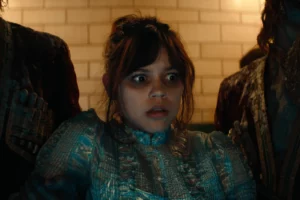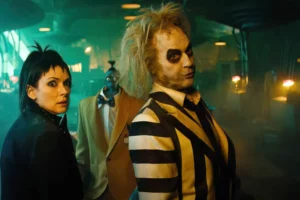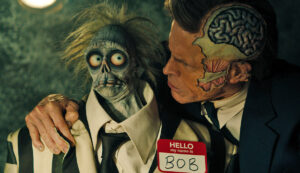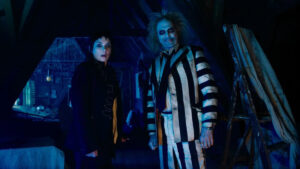Publication Date: 09-06-2024
Beetlejuice Beetlejuice (2024) review
Dir. Tim Burton
By: Steve Pulaski
Rating: ★★½
It’s been approximately 9,998,383,750,000 days since Beetlejuice arrived in theaters and solidified Tim Burton as more than a director, but a visionary, whose works would help define the artistic style of the 1990s. At the time, Warner Bros. probably thought they had the next Ghostbusters on their hands. Not only did they get something far weirder, they got something one would’ve assumed would’ve had a sequel many, many moons ago. It wasn’t for a lack of trying. Those of us of a certain age might remember reading the script for “Beetlejuice Goes Hawaiian” online and wondering just how joyously incongruent the tropical backdrops and madcap macabre would’ve married themselves to one another.
Contrary to most follow-ups that languish in development hell, a Beetlejuice sequel seemingly never manifested itself because Burton never fully committed to an idea. Funnily enough, in this era of regurgitated IP hell in which we reside, Beetlejuice Beetlejuice arrives into theaters out of thin-air given the repetitious start-stops in decades past. While rife with its own shortcomings, it’s a welcome return-to-form for Burton, whose last film, Dumbo, five years ago, felt like a cry for help, and apparently, kind of was in retrospect.

Beetlejuice Beetlejuice does come with some significant casting changes. The band is mostly back together, save for Alec Baldwin and Geena Davis, who have since left the attic. Glenn Shadix, who played Ortho Fenlock, passed away 14 years ago, and you can find out for yourself why Jeffrey Jones isn’t present.
Set 36 years after the events of the first film, we drop in on Lydia Deetz (Winona Ryder), who has grown up to become a paranormal talk show host. All seems well, but during one taping, she spots Betelgeuse (Michael Keaton) in the audience, and then shortly thereafter, her stepmother, Delia (Catherine O’Hara), phones to inform her that her father, Charles, passed away. Charles’ plane-crash/shark-attack death is shown through the use of what looks to be stop-motion animation; a needless, baffling aside, which is a statement for a Beetlejuice movie.
This prompts the obvious legacyquel move to get Lydia, along with her insufferable fiancée/manager (Justin Theroux) and daughter, Astrid (Jenna Ortega), to return to their “Ghost House” in Connecticut for the funeral. Delia mourns the loss of her husband by predictably using his passing as a source of inspiration for various forms of multimedia art. Astrid, like her mother at her age, couldn’t be burdened to care about anything, although Ortega sulking through much of her performance isn’t nearly as enjoyable as when Ryder did it. Ryder brought a Daria-esque level of apathy to her performance. Ortega operates like she’s in a bad mood.

Meanwhile, Betelgeuse is still loafing his way through the afterlife, but now his soul-sucking ex-wife, Dolores (Monica Bellucci), wants revenge on her former beau. In Burton’s most inspired sequence in a blue moon, Dolores is seen rebuilding herself ala early monster movies, such as Hammer Horror classics like Frankenstein as the Bee Gees’ “Tragedy” bumps in the background. After a rocky opening, which involves too many characters overexplaining themselves and their situations as if they have secondhand embarrassment for why they’re doing this all over again, this sequence truly stands out.
It takes roughly 40 minutes for Lydia to stop being a helpless sad-sack and Astrid to quit being a sullen mood-killer. Once that hurdle is cleared, Beetlejuice Beetlejuice starts to have fun with itself. It begins with the introduction of Jeremy (Arthur Conti), a teenaged boy whom Astrid meets after crashing her bike. The two have palpable chemistry, but screenwriters Alfred Gough and Miles Millar have other, smarter plans that reveal themselves in a shorter amount of time.
Burton’s long-awaited sequel has a lot in common with passion projects in development for years. They are burdened by too many ideas they cannot adequately flesh out. Even as Jeremy’s introduction kicks the plot into gear, it’s essentially a red herring for something else. And it’s not Delores, who also finds herself underserved. The second half of Beetlejuice Beetlejuice again revolves around Betelgeuse’s determination to marry Lydia, an unfortunate and unwelcomed occurrence for Delia, and Astrid learning that her mother wasn’t full of it this entire time.

Besides the fact that Keaton, Ryder, and O’Hara slink back into their respective roles with ease and giddiness, one of the elements keeping this sequel buoyant is its needle-drops. The previous film’s definitive sequence had to be the Deetz family being forced to sing and dance to Henry Belafonte’s “Day-O” during an otherwise routine family dinner. Here, it’s the climax’s inclusion of Richard Harris’ version of “MacArthur Park,” a visual ballad that’s lyrics are put to charmingly effective use thanks to Burton and Mark Scrunton’s production design. Donna Summer’s version complements the end credits, a delightful touch as well.
Beetlejuice Beetlejuice is the definition of a mixed bag sequel. For every positive, there’s a negative, threatening to limit the impact of something it dutifully accomplished. It’s a treat to see Tim Burton back in form, free to conceptualize craziness without being beholden to a Disney property or something that wasn’t originally his. The original Beetlejuice was lighting in a bottle. Its sequel captures enough of it without the glass shattering into a million pieces.
Starring: Winona Ryder, Michael Keaton, Jenna Ortega, Catherine O’Hara, Justin Theroux, Arthur Conti, Monica Bellucci, Willem Dafoe, and Danny DeVito. Directed by: Tim Burton.
About Steve Pulaski
Steve Pulaski has been reviewing movies since 2009 for a barrage of different outlets. He graduated North Central College in 2018 and currently works as an on-air radio personality. He also hosts a weekly movie podcast called "Sleepless with Steve," dedicated to film and the film industry, on his YouTube channel. In addition to writing, he's a die-hard Chicago Bears fan and has two cats, appropriately named Siskel and Ebert!


